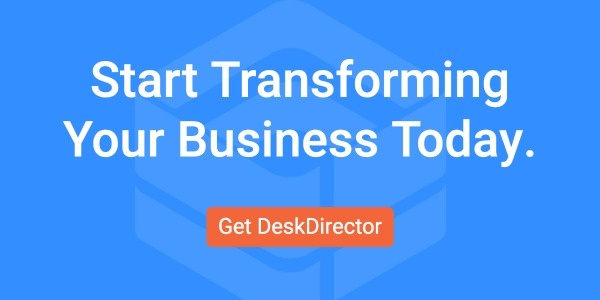Just 30% of employees say their experience with workplace tech exceeds their expectations. But as IT help desk techs face growing backlogs, it becomes harder to deliver the personalized support so many workers now demand.
That is why interest in IT help desk chatbots has grown in recent years – and this blog explores both the opportunities and challenges they present to make life easier for both techs and end-users.
Expect to learn:
- How chatbots improve end-user experience
- Why chatbots should never appear “human”
- What causes chatbots to provide unreliable information
What is a Chatbot?
Chatbots are automated programs that can respond to user queries in real time. While they have been around for decades, the last few years have seen a revolution in the technology – driven by large language models (LLMs) that can far more accurately mimic the speech and knowledge of a human being.

3 Ways Chatbots Can Improve Your IT Help Desks
Chatbots are an evolving technology, and companies are still experimenting with ways to use them within their IT help desk. However, there are three ways this technology has consistently proven to support IT organizations:
1. Reduce staffing burdens
From excessive workloads to shortages of qualified techs, many IT help desks face ongoing staffing issues. But techs’ time is still routinely taken up responding to end-user queries which could easily be automated – and chatbots are the perfect solution.
Chatbots can take over simple communications with end-users and resolve queries without the need for a human to step in.
This produces multiple benefits:
- Techs are less likely to be overworked or engage in tiring task switching
- Your staffing requirements are reduced, decreasing the need for expensive outsourcing
- Human expertise can focus on solving complex IT issues
2. Empower end-users
Some of the most common IT issues are relatively simple to solve and don’t require expert attention. But many end-users lack the confidence to go directly to your self-service knowledge base - and often have to wait hours or even days to hear back from a human tech.
Chatbots can offer automated guidance to help end-users solve their own issues. As a result, your end-users feel both more confident using self-service tools and more supported by the IT help desk.
3. Accelerate ticketing
Prioritizing IT tickets is essential to reduce downtime and maximize operational efficiency. But to triage and address tickets in a timely manner, techs need to know what the issue is – and that creates a problem for many end-users.
Chatbots can help end-users assess and articulate their IT problems more clearly. While your custom forms can present the right questions, end-users benefit from an actual dialogue (even if it’s automated!) and resources. The result? Clearer information, faster resolutions and a more effective IT help desk.
4 Common Pitfalls with Chatbots in IT Help Desks
Regardless of the media hype, chatbots are not a complete replacement for human labor. Any IT help desk should be aware of (and proactively mitigate against) these four challenges:
1. Inaccurate information
LLMs are well-known to confabulate – producing false information that comes across a bit like a human lying to conceal their ignorance. Left unchecked, this could lead your chatbot to provide inaccurate information to an end-user and exacerbate their IT problems.
The frequency with which chatbots confabulate varies, with studies estimating anywhere between 3% and 80% of the information provided is inaccurate. This tells us three things:
- All chatbots can produce false information, and should therefore always have protections in place to mitigate misinformation.
- Some chatbots are far more reliable than other, and your organization should shop around to ensure yours is as trustworthy as possible.
- Any chatbot you introduce to your help desk should be closely monitored – and leaders must never “set and forget” it
2. Misleading end-users
Chatbots built upon LLMs can appear indistinguishable from humans – especially in contexts like an IT help desk where the information exchanged is predominantly factual. However, many end-users will be actively put off if they feel you are trying to convince them a chatbot is human. Research from Oxford University finds that users get more frustrated at chatbots if they appear human-like.
The takeaway is simple: make sure all end-users understand that they are communicating with a chatbot. This could be achieved through an automated message from the chatbot itself, or simply by giving it a clearly non-human name.
3. Restricting access to humans
Chatbots are never a complete replacement for humans. But end-users may feel that LLMs are keeping them from talking to a human – and that is likely to have a detrimental effect on end-user satisfaction and ticketing adoption.
The solution is to make it clear and easy to request a human interaction. This will allow end-users to decide whether their query is urgent or can be solved with the help of a chatbot.
4. Functionality and outages
Few IT systems are invulnerable to outages – and that is a serious problem if your IT help desk is excessively reliant on chatbots. Imagine a system that relies on chatbots to report issues and the chatbot is temporarily out of service. Not only can end-users not submit requests – they may not know how to report that the system itself is out of service.
That is why you need to build clear fail-safes into the system. Chatbots can dramatically increase the efficiency of your IT help desk, but they must be implemented in a way that avoids creating extra vulnerabilities - and the best way to ensure that is working with proven experts when you introduce them.
Partner with DeskDirector to Transform Your IT Help Desk
With a range of smart automations and unique integration features, our software is trusted by hundreds of organizations – helping them resolve tickets 4x faster and increase ticketing adoption by 20%.
Want to discuss how we could help you leverage new technology like chatbots and advanced ticketing automation solutions?









